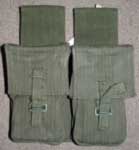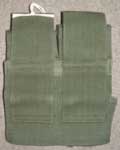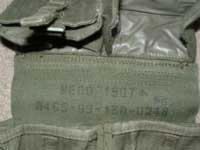| Karkee Web Home Page | Pattern 1958 Home Page | Patt. '58 Components Page |
Web Equipment, Pattern 1958 - Components
S.A.S. Add-on Items
 The particular requirements of the Special Air Service required items peculiar to them alone. Between the 1965 C.C.N. and 1976 C.O.S.A., a consecutively coded block of six items was added. The S.A.S. was deployed in the Indonesian Confrontation in Borneo (1962-66). The border with adjacent Indonesian territory is very mountainous (e.g. Mt. Kinabalu). In such an area, accurate navigation means an altimeter becomes essential. It is perhaps “2+2”, but perhaps this requirement, with an early use of the Armalite and the need for jungle survival techniques led to this block of S.A.S. specific items?
The particular requirements of the Special Air Service required items peculiar to them alone. Between the 1965 C.C.N. and 1976 C.O.S.A., a consecutively coded block of six items was added. The S.A.S. was deployed in the Indonesian Confrontation in Borneo (1962-66). The border with adjacent Indonesian territory is very mountainous (e.g. Mt. Kinabalu). In such an area, accurate navigation means an altimeter becomes essential. It is perhaps “2+2”, but perhaps this requirement, with an early use of the Armalite and the need for jungle survival techniques led to this block of S.A.S. specific items?
An interesting feature of these is the use of Patt. ’44 metal fittings. Where Patt. ’58 QR fasteners had rounded, drawn wire links, the QR fasteners here had the blanked, “squared” links that typify Patt. ’44 fittings. However, with the exception of the two Ammunition pouches, which include the words in their nomenclature, the C.O.S.A. Detail column gave them all Pattern 1958 W.E. nomenclatures. This inconsistency is assumed to be sloppiness in preparing the C.O.S.A., but does not answer why they were not “Patt. ‘44”. The Detail column also specifically includes the abbreviation “SAS”..
As first described, the Belt was fairly full-up, especially on someone of small girth. However, the Pack was above the cluttered belt. S.A.S. personnel were required to carry greater loads, for largely un-supported patrols over several days. They therefore employed the later developments of the Bergen “A” framed Rucksack. This had a lumbar support strap, stretched across the horns of the lower frame and this unfortunately coincided with where the Waist belt was. Therefore all these S.A.S. items had dropped loops, placing the Pouches below the Belt, with some having secondary loops, which allowed for wear on the Belt, if needed.
Troopers also developed their own personalised “Belt Order”, mixing the items below, with Patt. ’44 Water bottles and Carriers and Patt. ’44 Ammunition pouches, as well as Patt. ’58 standard items.
Stores Ref. CN 8465-99-130-0246 BRACES, INDIVIDUAL EQUIPMENT
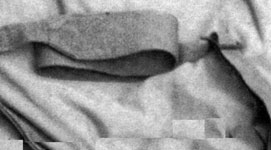 The spigot carrier on the Yoke also interfered with an “A” frame Bergen being worn. It was sometimes removed by soldiers, but the S.A.S. chose to have Braces made from 1-inch webbing. Simply fitted-out, they had plain belt loops at front and rear, flared shoulder sections and with length adjustment by means of a buckle at the front. Photo taken from British Special Forces 1945 to the Present, Uniforms Illustrated No. 13 (Arms & Armour Press, 1986).
The spigot carrier on the Yoke also interfered with an “A” frame Bergen being worn. It was sometimes removed by soldiers, but the S.A.S. chose to have Braces made from 1-inch webbing. Simply fitted-out, they had plain belt loops at front and rear, flared shoulder sections and with length adjustment by means of a buckle at the front. Photo taken from British Special Forces 1945 to the Present, Uniforms Illustrated No. 13 (Arms & Armour Press, 1986).
Stores Ref. CN 8465-99-130-0250 POUCH, ALTIMETER
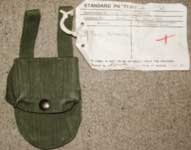
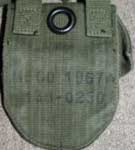 The Pouch was of narrow rectangular cross-section, but with a semi-circular base to accommodate the circular altimeter. A large eyelet in the rear wall allowed a lanyard to be threaded through, to guard against loss. A pair of dropped belt loops, in 1-inch webbing, were fitted. Due to the small size of this Pouch, it could only be worn below the belt line. The sealed Standard Pattern example shown here is maker marked "M.E. Co." and dated 1967. From the Allen Prior Collection. Photos © Allen Prior 2012.
The Pouch was of narrow rectangular cross-section, but with a semi-circular base to accommodate the circular altimeter. A large eyelet in the rear wall allowed a lanyard to be threaded through, to guard against loss. A pair of dropped belt loops, in 1-inch webbing, were fitted. Due to the small size of this Pouch, it could only be worn below the belt line. The sealed Standard Pattern example shown here is maker marked "M.E. Co." and dated 1967. From the Allen Prior Collection. Photos © Allen Prior 2012.
Stores Ref. CN 8465-99-130-0247 POUCH, AMMUNITION, 1958 Pattern, Self loading rifle

 This was a larger version of the Armalite pouch, holding four magazines. Like the Armalite, each of the linked pockets had a two-level belt loop – for below the Belt and on the Belt. The nomenclature, is presented exactly as it is in the Item column of C.O.S.A.., where “1958 Pattern” is perversely omitted from the Detail column! This sealed Standard Pattern example is not maker marked or dated, but presumably is from 1967, the date on the label. From the Allen Prior Collection. Photos © Allen Prior 2012.
This was a larger version of the Armalite pouch, holding four magazines. Like the Armalite, each of the linked pockets had a two-level belt loop – for below the Belt and on the Belt. The nomenclature, is presented exactly as it is in the Item column of C.O.S.A.., where “1958 Pattern” is perversely omitted from the Detail column! This sealed Standard Pattern example is not maker marked or dated, but presumably is from 1967, the date on the label. From the Allen Prior Collection. Photos © Allen Prior 2012.
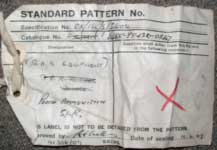
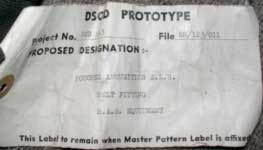
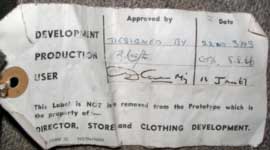 Details of the sealed Standard Pattern labels. Note that in addition to the Standard Pattern label, this Pouch also bears a DSCD Prototype label, which is marked "Designed by 22nd SAS".
Details of the sealed Standard Pattern labels. Note that in addition to the Standard Pattern label, this Pouch also bears a DSCD Prototype label, which is marked "Designed by 22nd SAS".
Stores Ref. CN 8465-99-130-0248 POUCH, AMMUNITION, 1958 Pattern, Armalite
The American 0.223-in Colt M-16 automatic carbine was adopted in the 1960s by Special Forces and such as the Gurkhas. The S.A.S. Pouch was a linked pair, each pocket divided laterally to contain one magazine, one in front, one behind. Thus each pouch held four magazines. The flaps were of box-lid form, closed by QR fasteners, the undersides of the lid being lined with waterproof coated nylon. The nomenclature, as in the S.L.R. Pouch above, is exactly as it is in the C.O.S.A. Item column, instead of in the Detail column, where all other references to “1958 Pattern” are placed. The sealed Standard Pattern example shown here is maker marked "M.E. Co." and dated 1967. From the Allen Prior Collection. Photos © Allen Prior 2012.
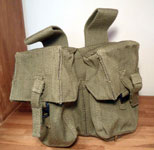 Another example of the Armalite pouch. Note the narrow belt loops compared to the Pouch shown above - this may be a commercial version.
Another example of the Armalite pouch. Note the narrow belt loops compared to the Pouch shown above - this may be a commercial version.
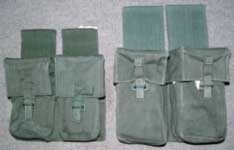
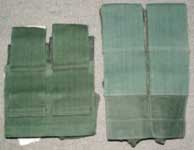 A comparison of the Armalite (far left in each photo) and SLR (near left in each photo) Ammunition pouches, showing their relative sizes. Photos © Allen Prior 2012.
A comparison of the Armalite (far left in each photo) and SLR (near left in each photo) Ammunition pouches, showing their relative sizes. Photos © Allen Prior 2012.
Stores Ref. CN 8465-99-130-0249 POUCH, RATION, ESCAPE
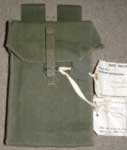
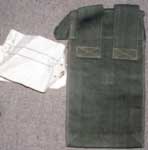 This was a broad Pouch about 2-inches from front to back, 6-inches wide and 8-inches deep. Into this went all the survival gear and emergency rations that might prove useful in a tight corner. A pair of dropped belt loops were stitched to the rear face. It is un-marked, but ought to be dated as the label, i.e. 1967. This sealed Standard Pattern example is from the Allen Prior Collection. Photos © Allen Prior 2012.
This was a broad Pouch about 2-inches from front to back, 6-inches wide and 8-inches deep. Into this went all the survival gear and emergency rations that might prove useful in a tight corner. A pair of dropped belt loops were stitched to the rear face. It is un-marked, but ought to be dated as the label, i.e. 1967. This sealed Standard Pattern example is from the Allen Prior Collection. Photos © Allen Prior 2012.
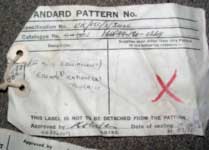
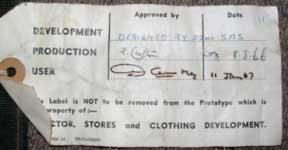
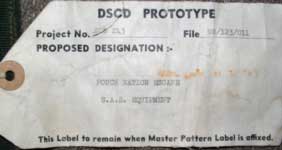 Details of the sealed Standard Pattern labels. As with the SLR Pouch above, this Pouch also bears a DSCD Prototype label, which is marked "Designed by 22nd SAS".
Details of the sealed Standard Pattern labels. As with the SLR Pouch above, this Pouch also bears a DSCD Prototype label, which is marked "Designed by 22nd SAS".
As an aside, Allen says he pulled all of these Standard Patterns out of an Army Cadet Force skip, whence they'd been dumped. On behalf of accoutrementalists everywhere, KW want to extend a special thanks to him for saving these important bits of military history!
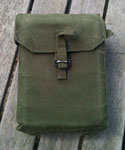
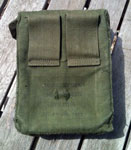
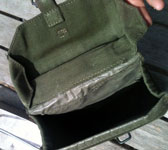 Another example. These photos were gleaned from an on-line auction and this actual Pouch has not been seen. The makers' mark is obscure, but it is dated 1987. Although it carries the correct stores designations and codes, the rear loops are sewn lower down on the body, so that the Pouch does not drop below the belt line when worn. It is not clear whether this is an actual design variation or if the loops have been relocated on this example. Any additional information will be gratefully received.
Another example. These photos were gleaned from an on-line auction and this actual Pouch has not been seen. The makers' mark is obscure, but it is dated 1987. Although it carries the correct stores designations and codes, the rear loops are sewn lower down on the body, so that the Pouch does not drop below the belt line when worn. It is not clear whether this is an actual design variation or if the loops have been relocated on this example. Any additional information will be gratefully received.
Stores Ref. CN 8465-99-130-0251 SHEATH, KNIFE
 This was actually a Sheath for a clasp knife, intended to contain a typical, proprietary knife, of what the Army once termed Trade Pattern. Examples such as Victorinox’s famous Swiss Army Knife being one. A length of 2-inch width webbing was folded upwards into a pocket and downwards on the reverse face, to form a belt loop. It was no more than that. From the Carl Woods Collection. Photo © Carl Woods 2012.
This was actually a Sheath for a clasp knife, intended to contain a typical, proprietary knife, of what the Army once termed Trade Pattern. Examples such as Victorinox’s famous Swiss Army Knife being one. A length of 2-inch width webbing was folded upwards into a pocket and downwards on the reverse face, to form a belt loop. It was no more than that. From the Carl Woods Collection. Photo © Carl Woods 2012.
Rog Dennis 2012
